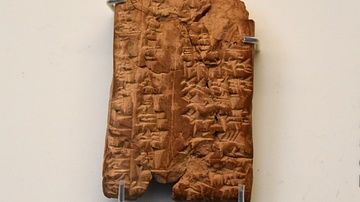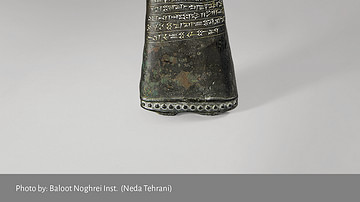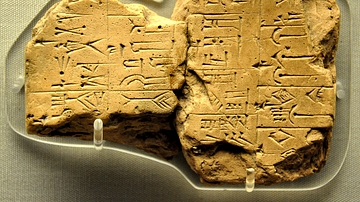Illustration
Early Elamite clay tablet with numerical signs found in Tappeh Yahya, Kerman, dating to c. 3100 to 2900 BCE (Yahya Period IVc).
National Museum of Iran, Tehran, inv. no. 4065.
Photo by Nima Fakoorzadeh (Baloot Noghrei)
Tappeh Yahya in southeastern Iran is a circular mound (= Tappeh in Persian) of c. 187 m in diameter and 20 meters high. With more than four millennia of archaeological remains, Tappeh Yahya marks the easternmost corner of "the Proto-Elamite horizon", hundreds of miles away from the Iranian portal of Mesopotamian influence in Susa. It was through this portal that the cuneiform writing system, developed by the Sumerians c. 3500 BCE, travelled on to the early Elamites c. 3000 BCE, although in its simpler, Akkadian form.
The proto-Elamite corpus of clay tablets contains over 1,600 pieces, with c. 10,000 lines of text. Many of these tablets include records of business transactions, taxes, tributes, and offerings. Economic inscriptions such as TY.11 here were compiled in a formulaic pattern with a title followed by a list of goods and the people involved in their trading. Numbers were written in the proto-Elamite decimal system using horizontal, bulky “wedges” (cuneus in Latin) and dots, persons and objects were represented with cuneiform ideograms. The text has two titles, a rarity perhaps suggestive of an administrative organisation supervising the transfer of the listed goods, here different numbers of rams, from the designated people to the superior holder of the second title. As a result, Y.11 could be part of an administrative system for collecting taxes and/or gifts in the early Elamite civic community, living thousands of years ago in Tappeh Yahya, southern Iran.
References
- Benjamin Mutin, C C Lamberg-Karlovsky. The Proto-Elamite Settlement and its Neighbors: Tepe Yahya Period IVC. Oxbow Books, 2013
- Clifford Charles Lamberg-Karlovsky. "Proto-Elamite Account Tablets from Tepe Yahya, Iran." Kadmos, vol 10, 1971, pp. 97-99.
- Damerow, Peter & Englund, Robert K. & Lamberg-Karlovsky, C. C. The Proto-Elamite Texts from Tepe Yahya . Peabody Museum Press, 1989.
- Sahar Yazdani and Rouhollah.Yousefi Zoshk. "Tribute or Taxation; New Evidence of the Structure of Iran’s Political Economy in the Proto-Elamite Period Based on a Proto-Elamite Tablet from Tepe Yahya: TY.11, Kept in Iran National Museum." Iran National Museum, 2020.
External Links
Cite This Work
APA Style
Iran, N. M. o. (2024, March 18). Early Elamite Clay Tablet with Numerical Signs from Southern Iran. World History Encyclopedia. Retrieved from https://www.worldhistory.org/image/18708/early-elamite-clay-tablet-with-numerical-signs-fro/
Chicago Style
Iran, National Museum of. "Early Elamite Clay Tablet with Numerical Signs from Southern Iran." World History Encyclopedia. Last modified March 18, 2024. https://www.worldhistory.org/image/18708/early-elamite-clay-tablet-with-numerical-signs-fro/.
MLA Style
Iran, National Museum of. "Early Elamite Clay Tablet with Numerical Signs from Southern Iran." World History Encyclopedia. World History Encyclopedia, 18 Mar 2024, https://www.worldhistory.org/image/18708/early-elamite-clay-tablet-with-numerical-signs-fro/. Web. 17 Jul 2025.






